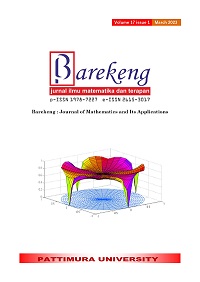A STUDY OF SMALL AREA ESTIMATION TO MEASURE MULTIDIMENSIONAL POVERTY WITH MIXED MODEL POISSON, ZIP, AND ZINB
Abstract
The research began with calculating the value of multidimensional poverty at the district level in West Java Province from SUSENAS 2021. The calculation of multidimensional poverty was based on individuals in each district or city household. The dimensional weights are weighed the same, and the indicators in the dimensions are also weighed the same. Furthermore, the simulation study used the Poisson, ZIP, and ZINB mixed models to examine the model's performance on data with cases of excess zero values and overdispersion. The simulation was by generating data without overdispersion and with overdispersion. Overdispersion data was generated with parameters of ω (0.1, 0.3, 0.5, and 0.7), and the model was evaluated from the AIC value. The best method in the simulation study was used to estimate multidimensional poverty in sub-districts in West Java Province using PODES 2021. Simulation studies on data without overdispersion showed no difference in the model's goodness. Overdispersion data shows Mixed Model ZIP and ZINB are better than Mixed Model Poisson. The percentage of the multidimensional poverty population at the sub-district level in West Java Province is quite diverse, from 0.04% to 75.54%.
Downloads
References
Badan Pusat Statistik, Penghitungan dan Analisis Kemiskinan Makro Indonesia Tahun 2021 [Calculation and Analysis of Indonesia's Macro Poverty in 2021]. Jakarta: BPS, 2021.
S. Alkire and M. E. Santos, “Measuring Acute Poverty in the Developing World: Robustness and Scope of the Multidimensional Poverty Index,” World Dev, vol. 59, pp. 251–274, Jul. 2014, doi: 10.1016/j.worlddev.2014.01.026.
United Nations Development Programme, Human Development Report 2010. New York: UNDP, 2010.
I. Molina and J. N. K. Rao, “Small Area Estimation of Poverty Indicators,” Canadian Journal of Statistics, vol. 38, no. 3, pp. 369–385, Mar. 2010, doi: 10.1002/cjs.10051.
N. Salvati, H. Chandra, and R. Chambers, “Model-Based Direct Estimation of Small Area Distributions,” Aust N Z J Stat, vol. 54, no. 1, pp. 103–123, Mar. 2012, doi: 10.1111/j.1467-842X.2012.00658.x.
J. Jiang and J. S. Rao, “Robust Small Area Estimation: An Overview,” Annu Rev Stat Appl, vol. 7, no. 1, pp. 337–360, Mar. 2020, doi: 10.1146/annurev-statistics-031219-041212.
L. G. B. Pinho, J. S. Nobre, and J. M. Singer, “Cook’s Distance for Generalized Linear Mixed Models,” Comput Stat Data Anal, vol. 82, pp. 126–136, Feb. 2015, doi: 10.1016/j.csda.2014.08.008.
C. B. Dean and E. R. Lundy, “Overdispersion,” in Wiley StatsRef: Statistics Reference Online, Wiley, 2016, pp. 1–9. doi: 10.1002/9781118445112.stat06788.pub2.
D. Lambert, “Zero-Inflated Poisson Regression, with an Application to Defects in Manufacturing,” Technometrics, vol. 34, no. 1, p. 1, Feb. 1992, doi: 10.2307/1269547.
D. S. Young, E. S. Roemmele, and P. Yeh, “Zero‐inflated modeling part I: Traditional zero‐inflated count regression models, their applications, and computational tools,” WIREs Computational Statistics, vol. 14, no. 1, Jan. 2022, doi: 10.1002/wics.1541.
Y. S. Wagh and K. K. Kamalja, “Zero-Inflated Models and Estimation in Zero-Inflated Poisson Distribution,” Commun Stat Simul Comput, vol. 47, no. 8, pp. 2248–2265, Sep. 2018, doi: 10.1080/03610918.2017.1341526.
S. Yang, L. L. Harlow, G. Puggioni, and C. A. Redding, “A Comparison of Different Methods of Zero-Inflated Data Analysis and An Application in Health Surveys,” Journal of Modern Applied Statistical Methods, vol. 16, no. 1, pp. 518–543, May 2017, doi: 10.22237/jmasm/1493598600.
R. N. Amalia, K. Sadik, and K. A. Notodiputro, “A Study of ZIP and ZINB Regression Modeling for Count Data with Excess Zeros,” J Phys Conf Ser, vol. 1863, no. 1, p. 012022, Mar. 2021, doi: 10.1088/1742-6596/1863/1/012022.
M. E. Brooks et al., “glmmTMB Balances Speed and Flexibility Among Packages for Zero-inflated Generalized Linear Mixed Modeling,” R J, vol. 9, no. 2, p. 378, 2017, doi: 10.32614/RJ-2017-066.
M. J. Brewer, A. Butler, and S. L. Cooksley, “The relative performance of AIC, AICC and BIC in the presence of unobserved heterogeneity,” Methods Ecol Evol, vol. 7, no. 6, pp. 679–692, Jun. 2016, doi: 10.1111/2041-210X.12541.
N. Istiana, “Pendugaan Area Kecil dengan Excess Zero (Studi Kasus: Angka Kematian Bayi di Pulau Jawa),” ["Small Area Estimation with Excess Zero (Case Study: Infant Mortality Rate in Java Island)"] Jurnal Aplikasi Statistika & Komputasi Statistik, vol. 13, no. 1, pp. 25–34, Sep. 2021, doi: 10.34123/jurnalasks.v13i1.270.
Copyright (c) 2023 Satria June Adwendi, Asep Saefuddin, Budi Susetyo

This work is licensed under a Creative Commons Attribution-ShareAlike 4.0 International License.
Authors who publish with this Journal agree to the following terms:
- Author retain copyright and grant the journal right of first publication with the work simultaneously licensed under a creative commons attribution license that allow others to share the work within an acknowledgement of the work’s authorship and initial publication of this journal.
- Authors are able to enter into separate, additional contractual arrangement for the non-exclusive distribution of the journal’s published version of the work (e.g. acknowledgement of its initial publication in this journal).
- Authors are permitted and encouraged to post their work online (e.g. in institutional repositories or on their websites) prior to and during the submission process, as it can lead to productive exchanges, as well as earlier and greater citation of published works.






1.gif)



